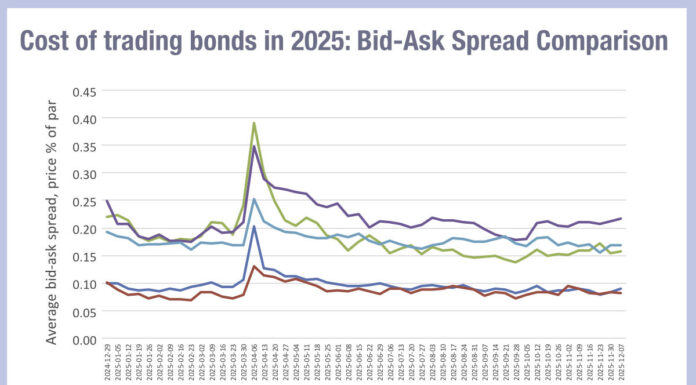Beige:
US Treasuries path forward likely to be moulded by lessons of other markets

By Josh Holden,
Chief Information Officer, OpenDoor Trading
At OpenDoor we recently celebrated the one-year anniversary of the launch of our trading platform. Over the past year we have printed trades, settled seamlessly, and quietly transformed a (small, but growing) portion of the U.S. Treasury market into a modern, anonymous, all-to-all marketplace. Perhaps most importantly, we have learned a lot. More on that in a moment.
It is not exactly a secret that bond trading has lagged other asset classes in technological innovation. Of course, the interdealer market has electronic exchanges for the liquid trading assets, just like equities and FX. Just like equities and FX, there are extremely liquid exchange-traded futures contracts. As a result of the inherent arbitrage between cash and futures, proprietary trading firms (PTFs) arrived, first bridging liquidity between these two worlds, and then supplying short-term liquidity themselves. Coupled with recent reductions in dealer risk appetite and balance sheet, this has generally lead to a wider, but shallower liquidity pool across all asset classes.
This is the point where the fixed income market begins to fall behind. Due in part to regulatory shifts, equities markets have seen a surge of innovation. Evolving with the changing landscape, significant innovations include discount electronic retail brokerage, day traders, algorithmic execution and transaction cost analysis (TCA), dark pools and exchange traded funds (ETFs). FX markets have seen a similar boom, supplementing a robust bilateral market-making model with exchange-traded, streaming and anonymous liquidity options. In contrast, recent U.S. Treasury innovation is limited to:
- Electronic platforms that basically mirrored the same request-for-quote (RFQ) workflow that had existed for the prior 50 years; and
- Rapidly-consolidating electronic interdealer trading venues.
The problem is that the underlying facts have changed. In a deep-liquidity market, price discovery is about finding the dealer counterparty most axed to do your trade. The markup from “standard” bid-ask spreads is likely to be smaller for size, and you could well get an inside price. In a shallow-liquidity market, bid-ask spreads can become vanishingly small for the initial (small) trade. The market impact of larger trades, however, can be many multiples of the standard bid-ask. In this case, price discovery becomes much more about the trade-off between immediacy of execution vs. total cost to transact.
In both deep- and shallow-liquidity cases, price discovery is paid for by giving up information. You disclose some portion of your trading intention to some or all of the marketplace, and in exchange you receive information about the current trading level and/or expected cost for stated size. As markets shift from deep to shallow liquidity, however, the value of the information you give up goes up dramatically. Shallow markets are perpetually in fear of the wave that is larger than their risk appetite. Meanwhile, the value of what you’re receiving in exchange for this valuable information – discovery of available price levels and liquidity – becomes increasingly commoditised. These days, anyone with a Bloomberg terminal can figure out where a small amount of US 10-year notes trade.
So, how will the fixed income markets adapt to the ongoing shift in market microstructure? We can look to Equities and FX for possible answers. First, expect to see the co-evolution of sophisticated execution algos, along with the TCA needed to measure their effectiveness, to take place in bonds as well. There are already several examples of forward-thinking firms in this space. At OpenDoor, we partner with one of them, Ideal Prediction, to evaluate “End User” trades done on our platform against multiple sources of tick data, to clearly demonstrate the value of anonymity to our clients. As TCA adoption increases, participants are likely to learn the same thing they have in other assets: Bid-Ask is often one of the smaller costs in trading, dwarfed by the costs associated with information leakage
Execution methodologies are likely to change as well. With RFQ alone, the simple act of putting a few dealers “in competition” and taking the best resulting price gives away the most valuable asset, order flow information, without actually informing the counterparty what the depth of book looks like. Not only does that order information go to the “winner” of the trade, but also to the “losers” as well, providing a perverse incentive for market makers to try to “always be the cover”. As a result, top-of-book bid-ask spreads may be tighter, but the speed with which trade flow information is transmitted into the marketplace is significantly greater. Just like water, shallow liquidity evaporates quickly.
If all the trades a given fixed income trader made over a given period were completely uncorrelated, this wouldn’t be a problem. We could evaluate them individually using a simple model of bid-mid t-costs and sum them up. But this is an unrealistic scenario for most buy-side accounts. Quite often fixed income trades are highly correlated over time, either by direction or sector or even issue. As a result, each marginal piece of information tipped to the market has a direct, measurable impact on overall execution efficiency. Evaluating the entire execution strategy, holistically, against a source of reliable tick-data, hopefully from a neutral third-party, becomes critical.
In other markets, it is quite common to see execution strategies that span a variety of venues. In fact, an entire industry of EMSs has developed to manage this exact workflow. Traders might first seek liquidity from those with the least information cost (anonymous dark pools, for example), before moving to an algo or lit venue. RFQ might be a last resort. This evolution in execution preferences, and the establishment of venues, protocols, and tools that support it, is a direct and natural reaction of the changing reality of market structure.
Which brings me back to the “lessons learned” in our first year here at OpenDoor. In the year since our launch, OpenDoor has handled tens of thousands of orders, supplying hundreds of billions of dollars (USD) in liquidity in off-the-runs and treasury inflation-protected securities (TIPS). When we launched, we thought that our main value proposition was that traders could trade at mid-market prices, often receiving price improvements when orders crossed. What we’ve heard, consistently, was that clients really valued trading at mid-market prices anonymously, with no penalty for disclosing full-size and best level. Many have likened it to a “free option” at liquidity, and the analysis we’ve done supports this view. Given the many execution options available in other highly liquid markets, perhaps the most surprising question we’ve heard over the past year is “What took you so long?”
©Markets Media Europe 2025












